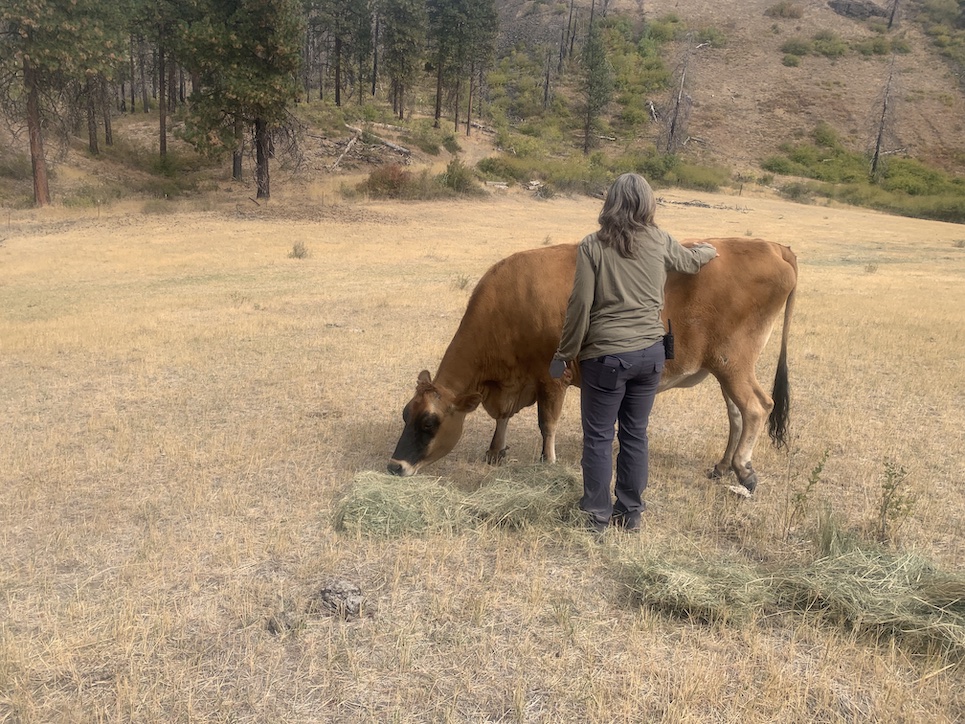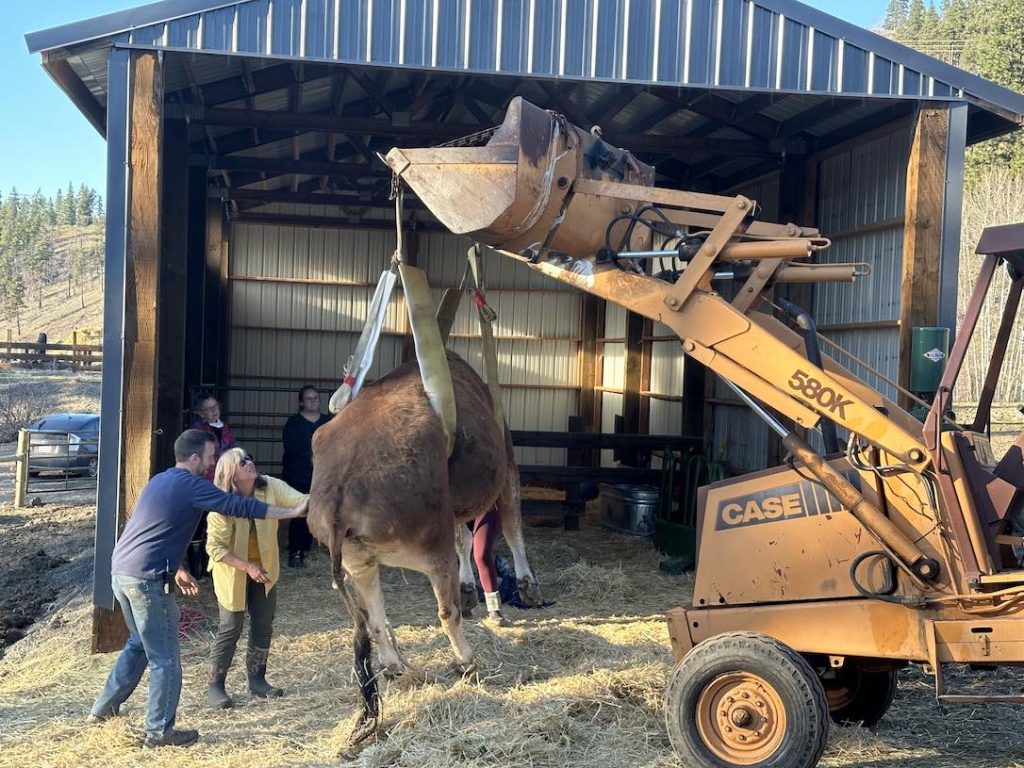We’re sorry to share that Nutmeg has passed away. This is the worst kind of news to share. I always worry about the impact of unexpected news on you all because I know how much you care about the animals here. And while we’ve had longer to absorb the reality of the situation, it’s coming at you all at once.
I know you’ll have a lot of questions, and I’m afraid that we just don’t have definitive answers in the case of Nutmeg. We did all we could for him and made the very tough decision to no longer prolong his discomfort, despite being left unsure about why his body failed him.
Dr. Erin, who has lost more than one night of sleep over the last few days, wrote the below about Nutmeg and her job in caring for him and his family.
Erin touched on this point, but I will add that it’s unusual to see adult male dairy cattle because the males are not economically useful to the industry. Dairy cattle have been bred with maximum milk production as the goal, and this genetic selection has resulted in males growing quickly and becoming very large. Nutmeg was so big that we had trouble finding a hoof trimmer with equipment that could accommodate his frame. While he was overall healthy in his time with us, we knew that his lifespan would likely not be incredibly long because of his size.
———-
From Erin:
I learned in veterinary school that I didn’t want to work with “farm” animals. I knew I wasn’t cut out to have a production value attached to my patients. Naive? Perhaps. But here I am, almost 35 years later, and the concept of inherent worth is still one I apply to all my patients, all animals, for that matter, no matter what species. My practice has focused on “companion” animals, dogs, cats and horses, and now, of course, chimpanzees. In 2018 when the sanctuary welcomed 4 beautiful Jersey cattle to the sanctuary, I thought, “ok Zamzow, here’s another species you aren’t familiar with to learn about!”
Heck, I learned about pigs by rescuing four of them so why not cattle too! Well, that knowledge from my “food” animal (now called “agricultural” animal) classes and rotations was buried alongside a few other traumatic experiences in my life. Yet, as once learned factoids tend to do, it bubbled up here and there and continues to be bolstered by online lectures, helpful, supportive, colleagues and, the best instruction of all, lived experience. I’m no expert by a long shot and I’d be lost without my cattle vet peeps (including the amazing and recently retired Dr. Mike Fuller here in Ellensburg) and colleagues from various veterinary school teaching hospitals.
I have come to cherish my time with our little herd. Getting to know them, their personalities, likes and dislikes and monitoring the health and well-being of these beautiful bovines is a pleasure and I often get ‘delayed’ in the barn or pasture because I enjoy being with them so much. These cattle get to exist free from the obligation to provide anything for humans-except of course, their natural grazing abilities that help to keep the property clear of excess fire fuel.
When the herd came to the sanctuary in early November of 2018, Nutmeg was not even 4 years old and already twice as big as his mother Betsy. In most dairy operations, a calf is separated from their mother anywhere from a few hours to a few days from birth, a traumatic event for both mother and baby. Fortunately some dairies leave cow and calf together for longer periods but they are still weaned earlier than if the decision were left up to mama and baby. In Nutmeg and Betsy’s case, the nursing went on, even if occasionally, for over 4 years. We rarely saw Nutmeg nurse after the herd came to CSNW but every so often someone would report seeing him sneak a sip from mom. Eventually, things ran their course and the milk bar closed for good.


This week has been a particularly tough one for all of us that love these cattle. Monday morning, Nutmeg was laying on his side in front of the barn and couldn’t get up. Cattle can and do lay on their sides once in a while but normally sleep in a ‘sternal’ position with their head curled around toward their back legs. Because of their size and the weight, like most megafauna, it’s not safe to lay on their sides for very long. Nerve and muscle damage can occur on their down side and the force of gravity causes blood to pool in the down side lungs. There is also the risk for ‘bloat’, a build up of gas in the rumen that can be life threatening. A normal adult bovine rumen holds about 40 gallons of fluid/ingesta, a lot of weight in that abdomen that puts pressure on other internal organs if they are in the same position for too long.
A “downer cow” is situation usually seen in cows after they have given birth and can be due to mineral imbalances or nerve damage sustained in delivery. In cattle on pasture, it can occur due to injury or a sudden shift in diet from hay to pasture that creates a drop in magnesium. It can be a hard condition to diagnose and sometimes, they just get down in the wrong position on an incline and can’t get their feet back under them.
We immediately got to work to turn Nutmeg onto his other side and then get him in a sternal position – no easy feat when dealing with a 2000 lb animal, but JB and Diana are amazingly creative when it comes to figuring out what one of our residents needs. We checked electrolyte and mineral levels, administered IV and oral electrolytes, dextrose and anti-inflammatory medications and monitored his vital signs closely. When a large animal is down, it’s important that they be watched continually in case they hurt themselves trying to get up. Nutmeg was propped up and watched around the clock with staff and volunteer Anthony taking shifts throughout the day and night. He was blanketed, brushed and doted on. JB was able to fashion a sling with some firehose so he could be lifted for short periods to take the weight off his legs. I did acupuncture and laser treatments on him as well which he initially seemed to respond to.
Nutmeg ate and drank water, chewed his cud and made valiant efforts to rise but by Wednesday afternoon, it was clear that he was exhausted and had sustained too much damage to his hind legs to recover. His appetite waned and the look in his eye changed. He spent his last night on a massive bed of straw in the barn, with his mama and Honey by his side and Meredith in her recovery pen just a few feet away. Staff visited and said their goodbyes and yesterday afternoon he was peacefully freed from his body and laid to rest surrounded by love.
Our hearts are broken and we will miss our beautiful, gentle giant so much. I am deeply thankful that he and his herd were sent to sanctuary instead of back to the dairy industry and that he was able to spend the last 5 1/2 years of his life grazing the pastures of this beautiful sanctuary with his family.
———-
We don’t talk about this much, but J.B. and I became vegan after first meeting chimpanzees and contemplating that line that humanity has historically drawn between “us” and “animals” and learning about industrial agriculture. We’re not perfect or pure vegans by any means, so perhaps the term plant-based is more appropriate, but we came to the decision from an animal welfare perspective, as did Dr. Erin many years ago. I think there are different ways of looking at personal food choices, and we certainly don’t expect everyone to come to the same decisions, but everyone should know what’s involved in producing the food they eat.
Our nearest neighbor manages a beef cattle ranch that harkens back to an older way of farming, where the cattle graze freely and contentedly. The calves stay with their moms and herds for some time before being separated, but, ultimately it’s still a for-profit business and they are separated and sold. This neighbor was more than happy to help us with Nutmeg when we first discovered our tractor was not strong enough to fully lift him off the ground. He brought his tractor over and helped us lift Nutmeg in the hopes that we could help him stand again. We are extremely grateful for Austin’s help, generosity, and undertanding.
It seems fitting to end this post with one of the last photos that Katelyn took of Nutmeg with his mom:
He will forever be her baby.




























